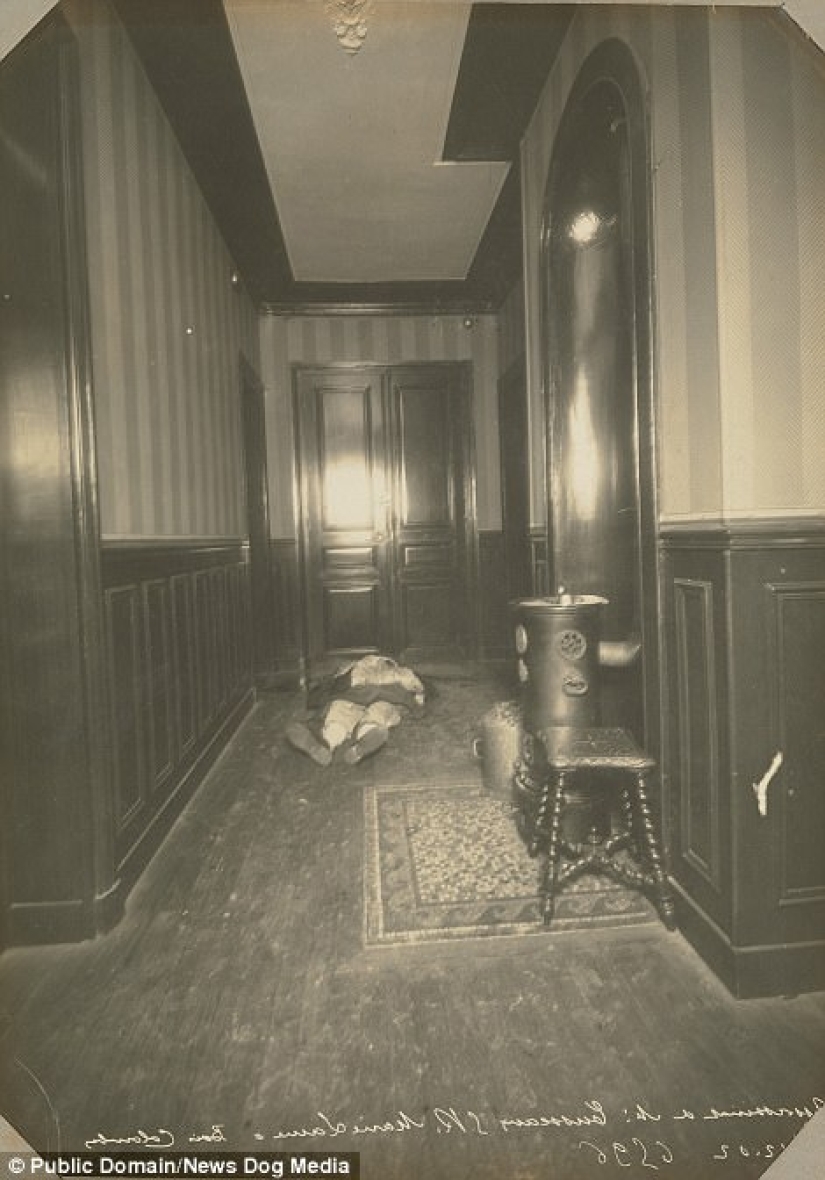First-of-its-kind crime scene photos from 1904
The photos of the last century were taken by lawyer Alphonse Bertillon, who worked in the French police in the XIX century and invented a method of identifying criminals by measuring body parts — the bertillonage system. He became a pioneer in criminology, which at that time was practically undeveloped.
And in 1888 Bertillon invented the mugshot. It was he who came up with the idea of using photographs as additional information to describe the appearance of the accused. The shooting was carried out full-face, in profile and in three-quarters of a turn. The researcher used a special chair in which the middle was convex and flat so that the person sitting on it could not move and the head could be kept at the same level.
Bertillon not only sat in the police office, judging by these shots, but also went to the crime scenes and carefully documented everything.

By the way, Bertillon's name was so well known that it is mentioned by Conan Doyle in The Hound of the Baskervilles, by Agatha Christie and Boris Akunin.
These shots are really unique, because at that time it was considered disrespectful and even disgusting to have such an attitude towards the dead. However, it soon became quite obvious that it was these "disgusting" photos that helped solve crimes, and the whole world began to envy the French police.

Another angle on the widow's body. Criminology in the late XIX — early XX century has just begun to develop. Bertillon was the first to notice that such seemingly insignificant details as the location of the body and the situation in the room could be the missing key to solving the crime.

The body of the widow Bol.

The caption to the photo: "A corpse has been found," the date is unknown.

Photo from the scene of the murder of the widow Bol, Paris, 1904. The inscription on the photo: "Inspection in the horizontal plane."

Madame Debanche was found dead on the floor of her apartment in Paris, on May 8, 1903.

Monsieur Fala was murdered in his sleep in his apartment, Paris, 1905.

The murder of Madame Tousseau, 1902.

The murder of Madame Lecombe, Paris, 1902.

Bertillon (pictured) was far from the first who guessed to photograph criminals. The officers of the Belgian prison did this back in 1843. However, it was he who came up with the mugshot style, including lighting and pose, which are used to this day.

A body was found in a Paris hotel, 1903.

"Body found on Rue Moreau, Paris." The date is unknown.

Another unknown body.

Murder on Lano Street, date unknown.

The body of Julie Guillemont, Paris, 1903.

Gilemon's body was turned on its back.

Photo caption: "On August 9, 1913, an elderly woman was found lying face down on Rue Rozier, Saint-Ouen. It looks like the birds in the cages are the only witnesses to the crime."

The caption to the photo: "The knife in the hands of the victim suggests suicide, but the investigation showed that Mademoiselle Ferrari was killed by her lover, Monsieur Garnier, who stabbed her in the heart."

The murder of Madame Lecom in the Rue Marty, Paris, 1902.

Body found in hotel, Paris, 1903.

Unknown body, Paris.

The body of an unidentified woman, Paris.

The bedroom of Madame Debenche, who was found dead on the floor, Paris, 1903.

The photo shows the consequences of an attempted murder. A bomb was thrown to kill King Alphonse XIII of Spain and French President Emile Loubet. As a result of the attack, 12 people were injured and a horse was killed.

The inscription on the photo: "The bedroom of the murder victim."

Madame Geran's body was found in an apartment in Courbevoie. Bertillon does not write where exactly the body was found.

The method of photographing the corpse as part of the identification of the person before the autopsy is demonstrated.

Disorder in the apartment of the murdered Madame Lecom.

Body detection. A human hand is visible in the ground.

A photograph of the murder scene.

The inscription on the photo: "The place where the body was found."

The victim's house.

Murder scene, Paris, 1903. Some of Bertillon's photographs from crime scenes are shocking manifestations of the violent nature of man. However, other frames seem scarier. The ones where, obviously, the victim didn't fight the killer.
Recent articles

Soon the New year, which means it's time to review Christmas movies, buying gifts, planning the celebration and decorate their ...

An old tradition to eat alcohol, kebabs, sausages and other meat products obviously there for a reason. Our ancestors, having a ...

Artists perpetuate the images of his muses in paintings, sculptures and other works. Them they draw inspiration for creativity. ...